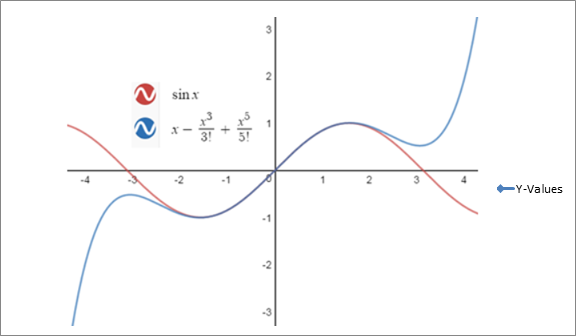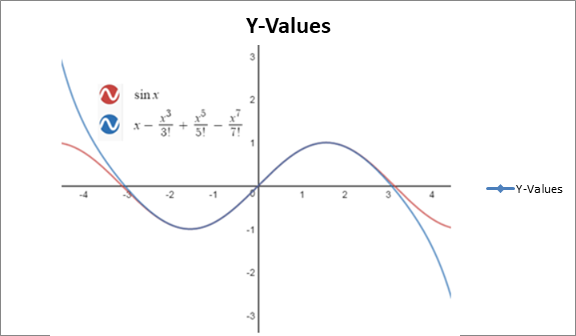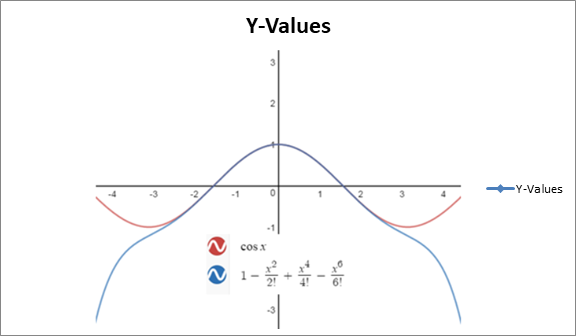
a.
To graph the sine function and its polynomial approximation in the same viewing window and compares the graphs using the graphing utility.
a.
Answer to Problem 113E
The polynomial function is a good approximation of the sine function for x- values near 0
Explanation of Solution
Given information: The sine and cosine functions can be approximated by the
Polynomials,
where x is in radian.
Calculation:
The graph of sine function and its polynomial approximation is given below.

The polynomial function is a good approximation of the sine function for x- values near 0.
b.
To graph the cosine function and its polynomial approximation in the same viewing window and compares the graphs using the graphing utility.
b.
Answer to Problem 113E
The polynomial function is a good approximation of the cosine function for x- values near 0.
Explanation of Solution
Given information: The sine and cosine functions can be approximated by the
Polynomials,
where x is in radian.
Calculation:
c.
To study the patterns in the polynomial approximations of the sine and cosine functions and predict the next term each. Then repeat parts (a) and (b) and find how did the accuracy of the approximations changes when an additional term was added.
c.
Answer to Problem 113E
The accuracy increase in both case when the term is added.
Explanation of Solution
Given information: The sine and cosine functions can be approximated by the
Polynomials,
where x is in radian.
Calculation:
The sign is alternating & both the exponents & factorial increases by 2 for each term so:
Using a graphing utility,


The accuracy increase in both case when the term is added.
Chapter 4 Solutions
PRECALCULUS W/LIMITS:GRAPH.APPROACH(HS)
- Force with 800 N and 400 N are acting on a machine part at 30° and 60°, respectively with a positive x axis, Draw the diagram representing this situationarrow_forwardI forgot to mention to you to solve question 1 and 2. Can you solve it using all data that given in the pict i given and can you teach me about that.arrow_forwardexam review please help!arrow_forward
 Calculus: Early TranscendentalsCalculusISBN:9781285741550Author:James StewartPublisher:Cengage Learning
Calculus: Early TranscendentalsCalculusISBN:9781285741550Author:James StewartPublisher:Cengage Learning Thomas' Calculus (14th Edition)CalculusISBN:9780134438986Author:Joel R. Hass, Christopher E. Heil, Maurice D. WeirPublisher:PEARSON
Thomas' Calculus (14th Edition)CalculusISBN:9780134438986Author:Joel R. Hass, Christopher E. Heil, Maurice D. WeirPublisher:PEARSON Calculus: Early Transcendentals (3rd Edition)CalculusISBN:9780134763644Author:William L. Briggs, Lyle Cochran, Bernard Gillett, Eric SchulzPublisher:PEARSON
Calculus: Early Transcendentals (3rd Edition)CalculusISBN:9780134763644Author:William L. Briggs, Lyle Cochran, Bernard Gillett, Eric SchulzPublisher:PEARSON Calculus: Early TranscendentalsCalculusISBN:9781319050740Author:Jon Rogawski, Colin Adams, Robert FranzosaPublisher:W. H. Freeman
Calculus: Early TranscendentalsCalculusISBN:9781319050740Author:Jon Rogawski, Colin Adams, Robert FranzosaPublisher:W. H. Freeman
 Calculus: Early Transcendental FunctionsCalculusISBN:9781337552516Author:Ron Larson, Bruce H. EdwardsPublisher:Cengage Learning
Calculus: Early Transcendental FunctionsCalculusISBN:9781337552516Author:Ron Larson, Bruce H. EdwardsPublisher:Cengage Learning





